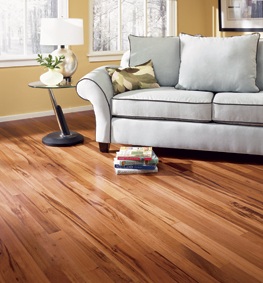
There once was a time when homeowners could either have hardwood floors or they couldn’t. There certainly wasn’t any middle ground. Oh, sure, there were hardwood flooring substitutes like vinyl flooring and, more recently, laminate flooring, but nothing on the market that combined real wood with the ability to stand up to moisture and lend itself to a quick and simple installation. Not, that is, until engineered wood flooring came on the market.
Engineered Wood Flooring Made For Everyone Installing an engineered hardwood floor need not be the tedious task it is wrongfully rumored to be. Engineered hardwood flooring was developed to address the needs of many homeowners and builders who want the beauty, strength, and durability of hardwood floors without much fuss. This option of flooring is made of up thin layers of wood stacked on top of each other in opposite directions with a real veneer of hardwood species on top.
Engineered hardwood floor construction Engineered wood flooring may consist of three or five layers, depending on the engineered hardwood type. Of course, the 5 layer option is likely far more resilient. Engineered wood is available as a floating floor that features a tongue and groove construction that snaps easily in place. This is perfect for DIYers who have only basic carpentry skills. Engineered hardwood flooring remains to be one of the most versatile flooring options there is. They can be installed in virtually any room of your home, even in rooms where solid hardwoods would suffer an ill fate. Installing Engineered Hardwood Flooring Engineered hardwood flooring installation is made easy by its tongue and groove construction that easily clicks together and locks in place. This is unquestionably a very easy flooring option to install when compared to solid hardwood flooring installation. Engineered floors can be glued down, nailed down, or even floated over existing floors like vinyl and ceramic tile.
Review Installation Instructions Thoroughly Should you decide to install the flooring yourself, be sure to read the instructions beforehand to help you get an idea on how an engineered hardwood flooring installation is supposed to proceed. Consult with other experienced installers if there are portions of the instructions that need clarification. If you think that you are not the proper person to install your engineered hardwood floor, do not hesitate to hire professional flooring contractors. Feel free to discuss your concerns, preferences, and requirements with them so that the finished product will be an engineered hardwood flooring that is to your liking.
Things to remember when installing engineered hardwood flooring Any successful floor installation starts with the preparation of the site in which the flooring will be installed. This also means that the site of installation must be appropriate for the engineered hardwood flooring. Engineered wood floors are more resistant to moisture than solid wood, but excessive moisture may make the floor warp and swell.
On the other hand, too dry conditions must also be avoided because this may lead to cracks in the engineered hardwood surface. Ask your flooring contractor or salesperson about the different types of engineered hardwood flooring available.
All flooring installations must start with reading the warranty and checking each board for damages and irregularities prior to installation. This is the responsibility of both the homeowner and the installer. Claims on already-installed boards are not usually honored.





